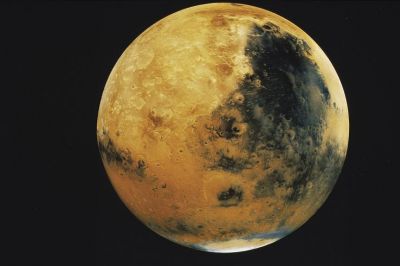













































If there was once microbial life on Mars, it probably existed underground. Evidence for this could be preserved on the surface where groundwater seeped up from the subsurface in places such as craters, according to research published in Nature Geoscience today.
A team, including planetary geologist Joe Michalski at the Natural History Museum, explain that rocks that have been uplifted from deep beneath the Martian surface by meteor impacts have been altered by water. They say that deep underground, nutrients and fluids necessary to support simple life have been present in stable environments, hidden from the harsh conditions at Mars' surface, for most of the planet's history.
Scientists speculate that up to 50% of the total mass of life on Earth exists as simple microbial life in the subsurface, in rocks up to several miles deep. In fact, the most ancient forms of life are very simple microbes that could have originated in the subsurface.
The team proposes that the same could have occurred on Mars. 'The surface of Mars has been extremely cold, oxidising and acidic for billions of years. But the subsurface of Mars may have always been habitable,' says Michalski.
Areas of crust between 2 and more than 5km in depth would have had enough chemicals, nutrients and energy, and an up-welling of groundwater to recharge nutrients, and therefore support distinctive microbial communities, the team says.
The best place to find evidence of groundwater up-welling and lifeforms on Mars are in the deep impact craters, such as one of the deepest, the McLaughlin Crater. Deep impact craters are caused when meteorites crash into Mars.
On Earth, lakes form in huge deep basins where groundwater reaches the surface. The same would be expected on Mars.
‘McLaughlin Crater probably contained one such lake. The sedimentary rocks within that crater could contain clues to the chemistry of the subsurface,’ says Michalski.
Clay minerals and carbonates have been detected in McLaughlin Crater. They suggest an alkaline lake environment, which is more favourable for life than an acidic one, such as has been suggested for many other regions of Mars.
Scientists searching for signs of life look for things such as complex organic molecules or potentially even fossil microbes.
Attention should focus on exploring the subsurface of Mars and places like McLaughlin Crater, the team says. Michalski explains,‘Our research presents a strong case for exploring the subsurface, as well as surface.
'But I don’t personally think we should try to drill into the subsurface to look for ancient life. Instead, we can study rocks that are naturally brought to the surface by meteor impact and search in deep basins where fluids have come to the surface.’
The research will also deepen understanding of Earth, explains Michalski. ‘One of the most interesting things about Mars science is that the planet might open a window into our own planet’s past.
'Earth’s geological record has been largely obliterated by plate tectonics, which means that we don’t have many intact rocks from the most ancient past. As Mars lacks plate tectonics, its ancient geological record is still intact. The environmental conditions on Earth and Mars were probably similar early on, so Mars gives us the chance to understand early biological or pre-biological processes here.’
Michalski concludes, 'Whether they contain life or not, rocks on Mars would certainly teach us a tremendous amount about early chemical processes in the solar system.’
Source: Natural History Museum